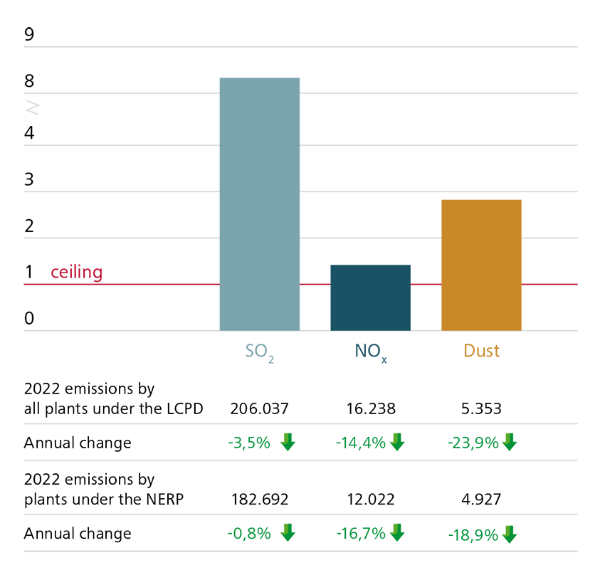
Bosnia and Herzegovina

 Membership
Membership
-
Overall implementation performance
Overall implementation performance 2023
CLUSTER INDICATORS 2023 HIGHLIGHTS AND NEXT STEPS .2023-12-08-13-48-12.png)
Markets and integration The Law on Electricity adopted in the Federation of Bosnia and Herzegovina in August 2023 defined the missing legal framework for unbundling of distribution system operators, however with a two-year implementation period. The virtual interconnection point introduced by Gas Promet Pale increases opportunities for gas trading. 
Decarbonising the energy sector Bosnia and Herzegovina submitted to the Secretariat its draft NECP within the prescribed deadline. Also its long-term low-emission development strategy was sent to UNFCCC. The Federation of Bosnia and Herzegovina adopted a renewable energy law and an energy labelling regulation, while Republika Srpska established an operational registry for guarantees of origin. Bosnia and Herzegovina should adopt the final NECP in line with the Recommendations provided by the Secretariat. Ensuring energy security No progress has been made in establishing a compliant legal framework governing the security of supply in electricity, gas and oil sectors. Improving the environment Environmental compliance remains low and the pressing issue of large combustion plants is still far from being resolved. The situation was worsened by the extended use of opted-out plants. Emission abatement measures must be taken immediately to address this. Performance of authorities The energy regulator’s institutional framework does not comply with the acquis. Within its limited legal competences, SERC continues to fulfill its regulatory tasks. The state aid authority rendered three decisions on illegal State aid. status: November 2023
source: compiled by the Energy Community Secretariat -
Dispute settlement cases
Dispute settlement cases
By end of the reporting period, Bosnia and Herzegovina had six dispute settlement cases.
Procedures under Article 91 EnCT where the procedure has been closed with the adoption of a Ministerial Council decision, but the breach has not been rectified yet. ECS-5/17 Electricity ECS-1/14 Energy efficiency ECS-3/18 Infrastructure Procedures under Article 92 EnCT where the breaches are not rectified despite adoption of Ministerial Council decisions establishing a serious and persistent breach or imposing measures under Article 92 of the Treaty. ECS-8/11S Gas ECS-2/13S Environment ECS-6/16S Third Energy Package status: November 2023
source: compiled by the Energy Community Secretariat
-
Primary fuel mix and available energy
2021 Fuel mix in primary production of energy (in ktoe)
status: November 2023
source: EUROSTAT
2021 Gross available energy per product (in ktoe)
status: November 2023
source: EUROSTAT
-
Primary supply of electricity
Fuel mix and primary supply of electricity
* net export [-]; negative value
status: November 2023
source: Ministry of Foreign Trade and Economic Relations, compiled by the Energy Community Secretariat
-
Implementation by market indicators
Implementation by electricity market indicators
Implementation by gas market indicators
* due to lack of gas market, the average excludes Kosovo* and Montenegro. The gas performance values are calculated on the basis of seven Contracting Partiesstatus: November 2023
source: compiled by the Energy Community Secretariat
-
Average annual prices
Average annual prices of electricity for end users per component
Average annual prices of gas for end users per component
source: EUROSTAT
Implementation by security of supply indicators
November 2023
source: compiled by the Energy Community Secretariat
Decarbonising the energy sector
-
Implementation by decarbonisation indicators
Implementation by governance indicators
Implementation by renewable energy indicators
Implementation by energy efficiency indicators
November 2023
source: compiled by the Energy Community Secretariat
-
2030 renewable energy targets and capacities
Targets for share of energy from renewable sources
Contracting Party 2005 Share of energy from renewable sources 2020 Target for share of energy from renewable sources 2030 Target for share of energy from renewable sources Bosnia and Herzegovina 34,0% 40% 43,6% source: Decision 2022/02/MC-EnC on incorporating Clean Energy Package into Energy Community acquis
2022 Total capacities of renewable energy (MW)
status: November 2023
aource: Ministry of Foreign Trade and Economic Relations
-
2030 energy efficiency targets, energy consumption and trends
2030 Primary and Final Energy Consumption (PEC) Targets
Contracting Party 2020 primary energy consumption (PEC) 2020 final energy consumption
(FEC)2030 primary energy consumption (PEC) 2030 final energy consumption
(FEC)Bosnia and Herzegovina 7,00 Mtoe 4,34 Mtoe 6,50 Mtoe 4,34 Mtoe source: Decision 2022/02/MC-EnC on incorporating Clean Energy Package into Energy Community acquis
2021 Primary Energy Consumption (PEC) and Trends
2021 Final Energy Consumption (FEC) and Trends
Energy intensity, 2021 value and trends: 0,44 ktoe/mil EUR, ↓ -3,7%
status: November 2023
source: EUROSTAT 2023 data, NECP and 2022 Ministerial Council Decision
-
Implementation by environment indicators
Implementation by environment indicators
November 2023
source: compiled by the Energy Community Secretariat
-
LCPD implementation
Installations Under the Large Combustion Plants Directive
Type of plants Number on plants 
of plants falling under the LCPD 13 
of which opted out plants 3 
of which plants falling under the NERP 10 source: compiled by the Energy Community Secretariat
2022 emissions versus NERP ceilings
source: compiled by the Energy Community Secretariat
Amount of operational hours used from opt-out period
Plant Expected expiry of opt-out period Remaining hours Operating hours consumed in 2018 - 2022 TPP
Kakanj 5EXPIRED 0 
22.058 TPP
Tuzla 4EXPIRED 0 
23.892 TPP
Tuzla 3November 2023 2.950 
17.050 Calculations for the expected expiry of the opt-out period are based on 2018 - 2022 average load factor.
source: compiled by the Energy Community Secretariat -
